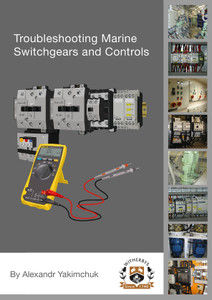
This handbook provides practical information relating to PLC-based appliances that are part of, or associated with, marine automation. It may be used as an onboard source of reference or as a step-by-step guide to develop familiarity with PLC-based systems and to practise and refine troubleshooting knowledge and fault finding skills.
Programmable logic controllers (PLCs) are used in a variety of applications in the marine industry, including propulsion systems, safety systems, data acquisition and motor starters. Marine engineers and ETOs must have a good understanding of these systems in order to maintain them in a safe and operational condition and to conduct efficient troubleshooting.
This book aids understanding of onboard applications and development of a systematic approach in the many troubleshooting cases likely to be encountered.
This publication is appropriate for:
- Management level marine engineers, operational level marine engineers, ETOs and electricians
- engineering cadets
- electrical engineering cadets
- anyone who is starting to work with PLC-based applications.
IMarEST members, please enter the promotional code ‘IMAREST’ during checkout for your members discount.
Programmable Logic Controllers (PLCs) are used in a variety of applications in the marine industry, including propulsion systems, safety systems, data acquisition and motor starters. They are reliable and require relatively little maintenance.
Marine engineers and ETOs must have a good understanding of automated systems, including PLC-based systems, in order to maintain them in a safe and operational condition. Since any onboard system can fail, fault finding also forms part of an engineer’s regular duties.
This handbook provides extensive practical information relating to PLC-based appliances that are part of, or associated with, modern marine automation. Using this book as a step-by-step guide will enable you to develop familiarity with the systems and to practise and refine your troubleshooting knowledge and fault finding skills.
This will help you to better understand onboard applications and to develop a systematic approach in the many troubleshooting cases you are likely to encounter.
This training package is appropriate for:
- Management level marine engineers
- operational level marine engineers
- ETOs and electricians
- engineering cadets
- electrical engineering cadets
- anyone who is starting to work with PLC-based applications.
1. PLC Basics
1.1 Introduction
1.2 Power Supply Modules
1.3 The Input and Output (I/O) Interface
1.4 PLC-based Application Terminology
2. Inputs
2.1 Sinking and Sourcing Input
2.2 Discrete Inputs (DI)
2.3 Input Designations
2.4 Discrete Inputs Interface Devices
2.5 Wiring Discrete Inputs
2.6 Analogue Inputs
2.7 Inputs Expansion Modules
3. Process Monitoring Analogue Sensors
3.1 Pressure Transducers
3.2 Resistance Temperature Detectors
3.3 NTC Thermistors
3.4 Thermocouples (TC)
3.5 Proximity Sensors
3.6 Feedback Potentiometers
3.7 AC Current Measuring Transducer
3.8 Analogue-to-Discrete Converters
3.9 Safety Stop Relays
3.10 Analogue-to-Analogue Signal Converters
4. Outputs
4.1 Definition
4.2 Protecting PLC Output Transistors
4.3 PLC Discrete I/O Status Display
4.4 Analogue Outputs
5. Flowcharts
5.1 Definition
6. Numbering Systems and Conversions
6.1 The Decimal System
6.2 The Binary System
6.3 The Octal System
6.4 The Hexadecimal (Hex) Numbering System
6.5 The Binary Coded Decimal
7. Ladder Logic
7.1 Definition
7.2 Relay Function
7.3 Impulse Relay Function
7.4 Latching Relay Function
8. Function Blocks
8.1 Definition
8.2 Logic Gates
9. PLC-based Direct-on-Line Motor Starter
9.1 Counter and Timer Instructions
10. PLC-based Star-Delta Motor Starter
10.1 Star-delta Motor Starter Ladder Logic and Function Blocks
10.2 Star-delta Reversing Motor Starter LAD and FBD Program
11. PLC Communication and Networking
12. Troubleshooting PLC-based Applications
12.1 Troubleshooting PLC-based Applications
12.2 PLC Application Troubleshooting
12.3 PLC-based Application Troubleshooting Tips
Witherby Publishing Group
Witherbys titles are developed using scripts developed by technical experts that are peer reviewed within work groups. Typically, they seek to improve understanding of the regulations, recommendations and guidelines issued by Industry.
Witherbys staff have significant expertise in the fields of navigation and hazardous cargoes as well as in the presentation of complex subjects in a graphic and easy to understand manner.
Alexandr Yakimchuk
Alexandr Yakimchuk has over 30 years’ experience in marine automation. He graduated from State Maritime Academy in 1987 and has a Master’s degree in Marine Automation and Electrical Installations Engineering. He gained sea experience on board cruise liners, rising to the position of Chief Electrical Engineer.
In 1997, Alexandr moved to a German ship management company with a fleet of over 40 container and heavy lift vessels. He became superintendent for automation in 2000 and undertakes inspections, repairs, and regular and emergency online troubleshooting tasks for the company managed fleet.
Alexandr is also a part-time interactive training developer and a trainer for Marlow Navigation – he has personally trained over 2,500 marine engineers. He has extensive experience in 2D and 3D CG and modelling, as well as circuit simulation skills. Alexandr works with a few training centres in Odessa and also manages emergency troubleshooting cases for various German shipowners. He has worked with Witherby Publishing Group since 2010 as an author and marine automation consultant.
IMarEST
IMarEST is the first Institute to bring together marine engineers, scientists and technologists into one international multi-disciplinary professional body.
Here you will find all the information you need about who we are, what we do and why we do it. You can also find out how IMarEST is governed, learn about the history of IMarEST, founded in 1889, and discover how our associated charity, The Guild of Benevolence, works to support those in the marine community requiring financial support.
- Number of Pages:
- 167
- ISBN:
- 9781856098120
- Published Date:
- January 2020
- Binding Format:
- Hardback
- Book Height:
- 285 mm
- Book Width:
- 170 mm
- Weight:
- 0.8 kg
- Author:
Alexandr Yakimchuk
- Preview:
- Yes






